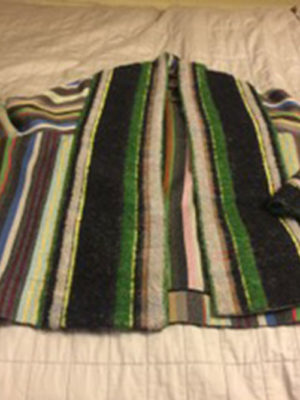YOU SAY CONSIGNMENT, recycle, thrift, charity or secondhand. I say therapy.
That’s said with some trepidation since one person’s idea of therapy is another person’s pain. But shopping for “gently used” apparel can offer emotional as well as economic rewards.
It’s the pride that comes with the thrill of finding a steal. That on your own, against the odds, you have discovered a favorite brand item marked down enough to convince yourself you can afford it.
It’s hearing people praise your savvy at spotting such a gem.
It’s the congeniality that springs up between strangers trading opinions and helping one another in and out of crowded fitting rooms.

This unusual striped jacket by Issey Miyake is a departure from contributor Ann Geracimos’s usual palette and gray and black. But as a consignment find, why not take a chance, she thought. / MyLittleBird photo.
It’s because your conscience is involved, being in touch with today’s environmental concerns by rescuing clothing that might otherwise end up in the dreaded landfill. Dressed in “pre-loved” fashion marks you as a “cool” citizen of the world.
The market is a multibillion-dollar-a-year industry, with fashion resale alone said to be growing 21 times faster than traditional retail. The stigma once associated with pop-ups and stores dealing in recycled goods is long gone. Smaller, more selective, boutiques thrive as well as lower-end thrift outlets. Consigning has become an art form, donating (“decluttering”), a necessity.
Not that the process is easy. The search takes time and talent, with many pitfalls along the way.
Not long ago, visiting my local consignment store on a whim, I spotted a colorful wool candy-striped Issey Miyake jacket displayed among other designer offerings on a top shelf. It is now a trophy item. I usually loathe stripes; had absolutely no need of a winter jacket; prefer long to short lengths; found its cut unsettling on my frame. But, reader, I was tired of a safe gray-and-black wardrobe; this “outside the box” garment seemed to fill a need I didn’t know I had. Maybe I needed to prove I could take a chance and not mind losing.
ClothesEncountersDC at Washington DC’s Eastern Market, has cultivated a family-friendly atmosphere over the years, building loyalty to make up in warmth what it lacks in physical space. Shopping there is a communal experience. Frequent customers are known by their first name.
Staff watches over toddlers in strollers so moms and nannies can browse. Dogs (and men) are cheerfully accommodated (standing room only). When a longtime customer who loves Edith Piaf stops by, the owner puts on the singer’s music. Clothes left over from seasonal sales are donated to a church pop-up operation that gives them away free to the less fortunate.
“People who have sensory-overload issues can’t stand it here,” says owner Gail Stern, whose professional background is marketing. “They want predictability—to see a style in different sizes. They find variety confusing.” She advises maintaining a love and knowledge of brands to understand when you are getting a bargain; to check how well a garment is finished on the inside if you are unsure. Quality determines price.
“Go not for need but for the game and go often,” urges Charly Shrewsbury, a twentysomething ad hoc buyer and seller in the greater Washington area. “Stake out those stores when you know turnover is greatest, such as a large Goodwill in a relatively upscale neighborhood. Find out when they restock, often the beginning of a week. And look for deal days. Sometimes there are discounts for seniors, or bargains for garments in different colors. Don’t be afraid to offer less than the tag price if you see an item has been on the racks a long time. Small stores need to clear space.”
“Don’t neglect hospital thrift shops and special-event sales. Relatives of the newly deceased may want to empty closets in a hurry,” adds her mentor mother Kate Shrewsbury of Culpeper, Virginia, a veteran retailer of vintage goods whose website, shopeveronward.com, advertises flannel and denim shirts “repurposed” with clever distinctive designs.
Both as buyer and seller, she keeps an eye out for large annual events such as the Annual Ladies Board Rummage Sale that takes place for two days each fall in a horse barn in Leesburg, Virginia, to benefit INOVA Loudoun Hospital and the Ladies Board Nursing Scholarship Fund. Donations begin early in the spring.
Larger for-profit stores as well as non-profit organizations usually have explicit instructions—often online—about how they work. It goes without saying that none deal in anything damaged or stained. Value Village, a self-described global thrift retailer whose slogan is “Shop, Reuse, Reimagine,” even publishes “rules for shopping habits.” Crossroads Trading, a national chain, pledges to pay 30 percent in cash upfront or 50 percent in trade on the spot. Goodwill’s Donation Guidelines list in detail the goods they do not accept.
Secondi, upstairs near Washington DC’s Dupont Circle, requires appointments for consignors and routinely lowers prices each month on unsold items, usually by a third. “Never come on a weekend if you expect any kind of personal service,” says a sales clerk. “Don’t hesitate too long. Quality items tend to go fast.”
It’s a game of chance every time.
—Ann Geracimos

You forgot Mustard Seed in Bethesda
great addition, thanks!